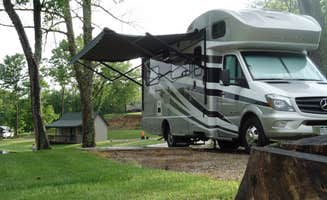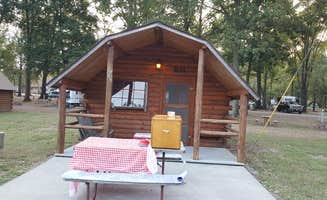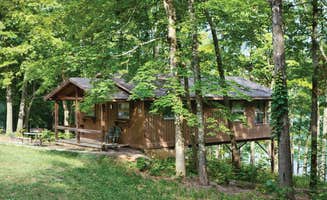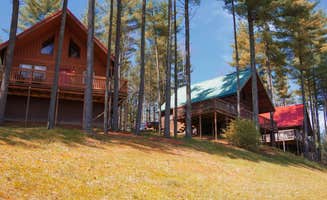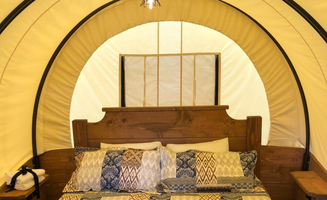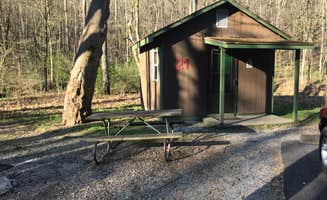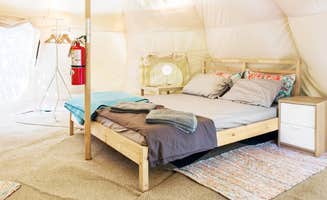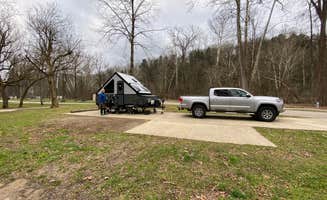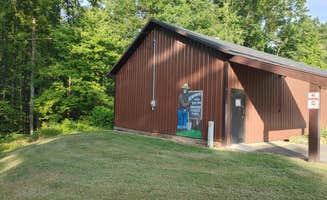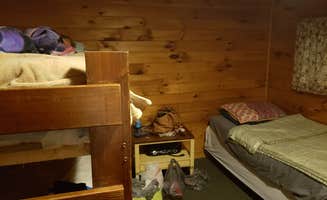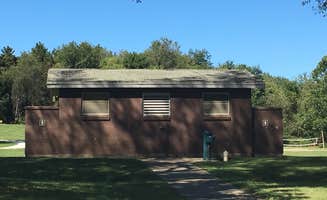Zanesville, Ohio sits at the confluence of the Muskingum and Licking rivers, creating diverse water recreation options within a mostly wooded terrain at elevations between 700-1,000 feet. The area experiences all four seasons distinctly, with summer temperatures typically ranging 70-85°F and winter temperatures often below freezing. Most campgrounds near Zanesville remain operational from April through October, though several offer year-round accommodations for visitors seeking luxury glamping in Zanesville, Ohio during off-peak seasons.
What to do
Archery practice: Jesse Owens State Park features dedicated archery ranges for all skill levels. "There's also an archery range but I did not go and check that out as I do not have a bow and arrow," notes a Hook Lake visitor. The range is accessible to all registered campers and doesn't require additional fees.
Fishing without licenses: Private campgrounds offer fishing opportunities without requiring state licenses. "The ponds are stocked with fish and because it is private land no fishing license is required. Basketball courts and a playground," reports a National Road Campground visitor. Most stocked ponds contain bass, bluegill, and catfish species.
Horseback riding: Walkabout Creek Horsemans Camp offers extensive trail access specifically designed for equestrians. "Great great campground plenty to Joe we took the horses had a blast," shares one reviewer. The campground provides hitching posts, water access for horses, and direct connections to miles of riding trails.
Lake activities: Multiple watercraft rental options exist throughout the area for visitors without their own boats. "We hope to come back and back pack one of the trails," mentions a Burr Oak State Park visitor, who adds "We actually stayed at the lodge and it was lovely. We would hike around during the day and swim inside as it was before spring."
What campers like
Spacious sites: Many campgrounds offer larger-than-average sites that accommodate multiple tents or larger RVs. At LA-Z Acres Campground, a visitor notes, "Bonus they just opened up a new section that makes you feel like you are on your own piece of heaven." Sites range from compact tent pads to large pull-throughs exceeding 80 feet.
Clean facilities: National Road Campground maintains high cleanliness standards throughout its facilities. "My family and I were just passing through for the night, and the vibe was great. It was quiet, clean, easily accessible, and offered a wide range of amenities," reports a pleased camper. Shower facilities typically feature hot water and regular maintenance.
Quiet atmosphere: Despite proximity to Interstate 70, many campgrounds maintain peaceful environments. "Dillon Lake State Park is located about 10 miles west of Zanesville, OH in a heavily forested area. There is no road noise from the local route 146 used to access the campground," shares a Dillon State Park visitor. Many sites provide buffer zones of trees between camping areas and roadways.
Free camping options: Budget-conscious travelers can access no-cost camping within the region. "This is a free campsite that was part of the AEP reclamation lands," explains a Hook Lake camper, who clarifies, "The state of Ohio recently bought it so it is becoming the Jesse Owens State Park. We did talk to a ranger while we were at the campground."
What you should know
Limited utilities: Some campgrounds offer minimal services, particularly in primitive areas. A Blue Rock State Park camper shares, "Nice little campground. We had a secluded site right beside the creek. The only negative was no flush toilets, only pits and so sink to was hands, but there was hand sanitizer at least."
Seasonal considerations: Water access may be restricted during certain periods. "We did not swim due to frequency of E-Coli warnings at this lake which was disappointing as it was very warm," reports a Salt Fork State Park visitor. Water quality reports are typically posted at beach and swimming areas weekly during summer months.
Cell coverage varies: Connectivity can be limited in rural campgrounds. "Even with Verizon there were several spots where I did not get coverage," notes a Jesse Owens State Park camper. Some campgrounds provide Wi-Fi at central facilities, but signal strength varies considerably throughout camping areas.
Leveling challenges: Some sites require equipment to achieve level setups. "Pull-thru site #18 was very unleveled from front-to-back; hitch was on ground and rear stabilizers were fully extended with blocks underneath," reports a National Road visitor. Bringing leveling blocks is recommended, particularly for larger rigs.
Tips for camping with families
Playground access: Multiple campgrounds feature dedicated play areas for children. "We enjoyed fishing as well as watching our child on the playground and splash pad!" shares a visitor to National Road Campground. Most play equipment is suitable for ages 3-12, with splash pads typically operational from Memorial Day through Labor Day.
Fishing opportunities: Youth-specific fishing areas allow children to experience angling without competing with adults. "At the campground children up to the age of 15 are allowed to fish. Adults need to go elsewhere to fish," explains a Hook Lake camper. Many ponds are well-stocked and feature accessible shorelines for young anglers.
Cabin options: Buckeye Lake KOA offers family-friendly cabin layouts with separate sleeping areas. "The design is nice as the bunk beds are in their own separate room. This means the back room will sleep four individuals," explains a visitor, who adds, "Due to health code rules you have to cook and do food outside of the cabin."
Wildlife viewing: Natural areas around campgrounds provide opportunities to observe local fauna. "My partner and I have been here for 3 days, were staying for a week. So far everyone has been friendly or keeps to themselves. The bathrooms and showers are clean and the deer are plentiful and beautiful," reports a Dillon State Park camper.
Tips from RVers
Site selection: Choosing sites away from major campground thoroughfares can significantly improve the camping experience. "Go to the back of the campground. It is very quite," suggests a Dillon State Park reviewer. Corner sites and those at the end of loops typically provide additional space and privacy.
Uneven terrain: Many campgrounds feature sloped sites requiring leveling equipment. "Many sites are not level. Many sites have NO shade. Only Electric available at each site," notes a Dillon State Park camper. Bringing extra leveling blocks and measuring site dimensions before booking helps ensure a comfortable setup.
Road conditions: Some campgrounds have deteriorating internal roadways. A Spring Valley visitor reports, "Roads in the campground are very rough with large potholes." Driving slowly and checking campground websites for construction notices helps avoid unexpected challenges.
Reservation timing: Popular campgrounds fill quickly during peak season. "We usually stay about a week to attend conventions or go antiquing. Wish they still had cable. Nice wide pull thrus," shares a Spring Valley camper. Reservations should be made 3-6 months in advance for summer weekends and holiday periods.


